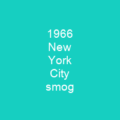Understanding Air Pollution: A Global Crisis
Imagine the air you breathe as a canvas, painted with invisible pollutants. Each breath we take is like dipping our brush into this toxic mix, unaware of the consequences. Air pollution, a silent yet pervasive threat, has become one of the most pressing issues of our time. It’s not just about smog and haze; it’s about the health of every living being on Earth. Let’s dive deep into what air pollution is, its sources, effects, and how we can combat this global crisis.
The Nature of Air Pollution
At its core, air pollution is the contamination of our atmosphere by harmful substances. These pollutants can be in the form of gases, particles, or even biological materials. They come from both natural and human-made sources, creating a complex web of environmental challenges.
Natural vs. Anthropogenic Sources
While nature plays its part through volcanic eruptions and wildfires, it’s the anthropogenic sources that dominate today’s air pollution landscape. Think of these as the human activities that release pollutants into our atmosphere: burning fossil fuels for energy, industrial processes, transportation, and waste management.
The Impact on Human Health
Air pollution is no longer just a concern for environmentalists; it’s a public health crisis. The World Bank estimates that air pollution costs the world economy $5 trillion per year, highlighting its profound economic and social impacts.
Diseases Linked to Air Pollution
The effects of poor air quality are far-reaching, affecting everything from respiratory infections and heart disease to lung cancer. Even mental health isn’t spared; exposure to pollutants can lower IQ scores and contribute to anxiety and depression. It’s a silent killer that affects everyone, but the most vulnerable—children, the elderly, and those with pre-existing conditions—are hit hardest.
Global Hotspots
The world’s most polluted city, Tehran, was declared in 2022, but air pollution hotspots are scattered across continents. In India and China, millions die prematurely each year due to indoor and outdoor air pollution. Even in the United States, cities like Los Angeles and New York struggle with high levels of smog and particulate matter.
Indoor Air Pollution
It’s not just about what we see outside; indoor air quality is equally concerning. Indoor pollutants such as asbestos, radon, and tobacco smoke can cause respiratory irritation, asthma, heart disease, lung cancer, stroke, and chronic bronchitis. The lack of ventilation indoors exacerbates these issues, making our homes and workplaces potential hotbeds for pollution.
Environmental Impact
The effects of air pollution extend beyond human health; they impact the environment as well. Acid rain, caused by sulfur dioxide emissions, damages forests and aquatic ecosystems. Ozone depletion from chlorofluorocarbons (CFCs) leads to increased UV radiation, harming plants and wildlife.
Climate Change
Air pollution is intertwined with climate change. Greenhouse gases like carbon dioxide contribute significantly to global warming. The United Nations estimates that 7-9 million people die prematurely each year from air pollution, highlighting the urgent need for action.
Combatting Air Pollution
The fight against air pollution requires a multi-faceted approach, involving technological innovations, policy changes, and individual actions. From transitioning to renewable energy sources like wind and solar power to implementing stricter emission standards for vehicles and industries, every step counts.
Regulations and Technologies
Effective laws and regulations are crucial. The United States Environmental Protection Agency (EPA) sets limits on certain air pollutants under the Clean Air Act. Similarly, international bodies like the European Union have implemented directives to control emissions.
The Future of Air Quality
As we look towards a sustainable future, it’s clear that reducing our reliance on fossil fuels is key. The transition to clean power sources and electric vehicles offers hope. However, this journey requires global cooperation and commitment from every individual and organization.
Conclusion: A Call to Action
The air we breathe is a precious resource that needs our protection. From the bustling streets of Beijing to the serene landscapes of rural India, air pollution affects us all. It’s time for us to take responsibility and work together to clean up our act. By reducing emissions, improving indoor air quality, and supporting policies that promote sustainability, we can create a healthier planet for future generations.
Remember, every breath counts. Let’s make the air we breathe cleaner, safer, and more sustainable. The time to act is now.
You want to know more about Air pollution?
This page is based on the article Air pollution published in Wikipedia (retrieved on November 24, 2024) and was automatically summarized using artificial intelligence.






